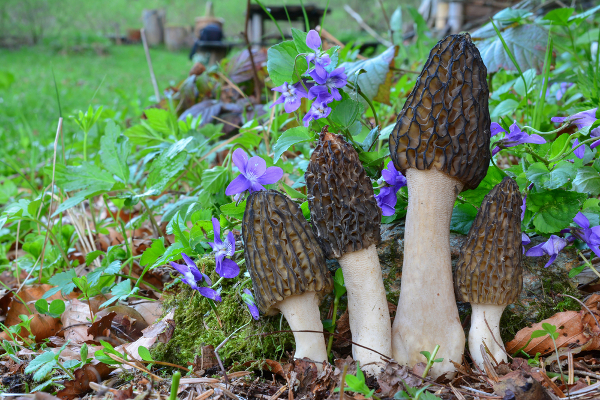Foraging for wild mushrooms offers the unique allure of Morels, prized for their distinctive appearance and culinary value. Identifying Morels requires attention to detail, noting the intricate honeycomb patterns on their caps and key stem characteristics.
Distinguishing true Morels from lookalikes involves subtle nuances. Mastering these identification techniques is not only a skill but also opens the door to a rewarding and potentially delicious pursuit.
Morel Mushroom Overview
Morel mushrooms, from the Morchella genus, are highly prized for their distinctive honeycomb appearance, earthy flavor, and rich, nutty taste that intensifies when cooked.
They come in various colors like black, gray, yellow, and white, each offering a slightly different flavor profile. These mushrooms are valued for their meaty texture, which holds up well in dishes like soups, sauces, and sautés.
In addition to their culinary appeal, morel mushrooms are a good source of nutrients like copper, vitamin D, and iron, making them both flavorful and nutritious.

Morel Habitat and Seasons
Identifying morel mushrooms requires knowledge of their habitat and preferred seasons. Look for them in areas with specific trees, soil conditions, and moisture levels.
Harvest during the ideal times for a better chance of finding these prized fungi.
Prime Morel Locations
During spring, experienced foragers target habitats rich in organic matter and moisture, like old apple orchards, ash, elm, and oak forests, and areas impacted by wildfires, to find Morel mushrooms.
Morels thrive in soil enriched with organic debris near trees, especially dying or dead ones, and in areas with recent disturbances like landslides or floodplains. Focusing on these prime locations increases foragers’ chances of a successful harvest.
Ideal Harvesting Times
To ensure a successful Morel mushroom harvest, consider the following key points:
- Morels typically appear when the soil temperature reaches around 50-60°F.
- Adequate dampness levels in the soil are essential for successful fruiting.
- Morels are commonly found in the spring, with their appearance varying based on location and climate.
- Early morning or late afternoon are the best times for harvesting Morels as they are more likely to be visible.
Identifying Morel Cap
Identifying Morel mushrooms involves examining the distinctive cap, important for distinguishing different species.
The cap is typically conical or morel-shaped, with a honeycomb-like surface.
Colors range from light tan to dark brown, blending with surroundings for camouflage.
The cap’s texture is deeply pitted and ridged, resembling a sponge or brain-like pattern.
False Morels may have wrinkled caps lacking the honeycomb structure, and the cap should be firmly attached to the stem without loose connections.
Understanding these cap characteristics is essential for accurate identification and differentiation from harmful look-alikes.

Examining Morel Stem
When examining a Morel stem, note the following key characteristics:
- Texture: Hollow stem attached to the cap, smooth surface.
- Color: Lighter than the cap, ranging from white to light cream or slightly yellow.
- Length: Typically longer than other mushrooms, proportional to cap.
- Base Attachment: Stem attached to cap bottom without gaps.
Understanding Morel Spore Print
Understanding the reproductive process of Morel mushrooms involves obtaining a spore print.
This involves collecting and examining the spores released by the mushroom, which can vary in color from white to yellow or black.
To get a spore print, separate the cap from the stem, place the cap gills down on paper or glass, cover it, and let it sit undisturbed for hours.
The spores will form a pattern below, aiding in identification of different Morel species for a safer foraging experience.
Morel Look-Alikes
When foraging for Morel mushrooms, being able to distinguish them from potential look-alike species is necessary to avoid consuming harmful mushrooms.
Some common Morel look-alikes to watch out for include False Morels (Gyromitra species), Verpa Bohemica (Thimble Morels), Cup Fungi (Sarcoscypha or Peziza species), and Stinkhorns (Phallus species).
False Morels are toxic if consumed raw, Thimble Morels have a cap attached at the top of the stem, Cup Fungi lack hollow interiors, and Stinkhorns have a foul odor and are not edible.
Being able to recognize these differences is essential for a safe foraging experience.
Safety Precautions for Morel Hunting
Before heading out for Morel mushroom hunting, ensure you have the right gear: a mushroom identification guide, a sharp knife, and a sturdy basket. Wear long pants, long sleeves, and sturdy boots for protection. Bring extra water, snacks, and a charged phone.
Inform someone of your location and return time. Be cautious with wild mushrooms to avoid poisoning.
Morel Hunting Tips and Tricks
Here are some key strategies for successful morel mushroom hunting:
- Timing: Hunt in the spring when temperatures are between 60-70°F during the day and above 40°F at night.
- Location: Look near elm, ash, and apple trees, in recently burned areas, and in well-drained soil in forests, riverbanks, and orchards.
- Observation: Train your eyes to spot morels’ honeycomb caps amidst forest clutter.
- Networking: Learn from local mycological societies or experienced foragers to improve your skills and find new hunting spots.
Morel Harvesting and Storage
For optimal quality and longevity of your morel mushroom harvest, it is essential to harvest them by cutting at ground level to preserve the mycelium.
Using a mesh bag or basket during harvesting helps spores disperse for future growth.
To store morels, place them in a paper bag in the refrigerator to prevent sweating, or dry them for long-term preservation and flavor retention.



